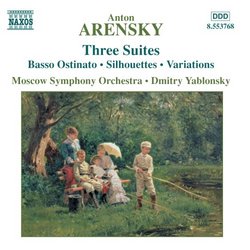Color and Verve: The Orchestral Suites of Arensky
04/22/2004
(5 out of 5 stars)
"This is a pretty delicious disc! First of all, the music. Anton Arensky was a contemporary of Glazounov and like him, an admirer and imitator of Tchaikovsky. If you're familiar with Arensky's rather sedate tribute to Tchaikovsky, the Variations on a Theme by Said Master (once about the only piece you heard by the younger composer), you may be surprised to find that Arensky is capable of much more unbuttoned moods. In fact, his Suite No. 2, a set of musical portraits in the style of Schumann's "Carnival," manages to create witty little send-ups of stock characters such as the coquette, the buffoon, and the dreamer. But I especially like the mock seriousness of the first piece, "The Savant," and the colorful orchestration and panache of the last, "The Dancer."Taken altogether, this is the finest of the three suites, but there are charming bits in the others as well, and the long set of variations that make up Suite No. 3 (sort of like the famous Theme and Variations from Tchaikovsky's Suite No. 3) have some quite memorable moments, including a Nocturne in which the orchestral piano provides liquid Debussyian arpeggios a la Claire de Lune. The inclusion of the piano is a rarity in music of the 1890s (after all, the first appearance of the piano in the orchestra came with Saint-Saens' Organ Symphony written about ten years before), but Arensky uses it both tellingly and tastefully. It adds great charm to the Menuet de XVIIIeme siecle, which--as you can imagine--is about as 18th-century as Tchaikovsky's Mozartiana or Rococo Variations--less so, in fact. But with its tinkly keyboard figurations, and punctuated by the triangle, this is a charming little period piece. There's some rather unhealthy bombast, too, in the Marche triomphale and the Polonaise that rounds off the suite, but it is well compensated for by the expressive Marche funebre and the Nocturne I spoke about earlier. Altogether, Suite No. 3 is a very attractive work.I find the performances by Dmitry Yablonsky and the Moscow Symphony exemplary. No quavering horns and nasal woodwinds here as in the bad old days of Russian orchestras. The playing is clean and lively, and the recording is as full and colorful as the music. Give Anton Stepanovich a listen; just the thing to chase the blues on a rainy afternoon."


 Track Listings (20) - Disc #1
Track Listings (20) - Disc #1